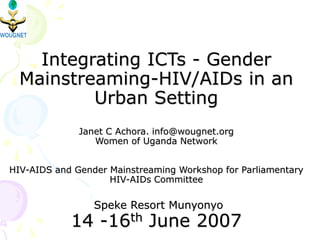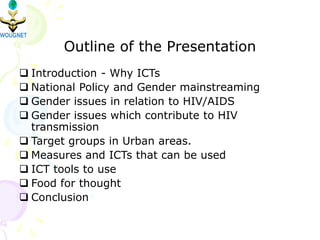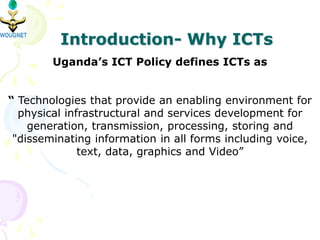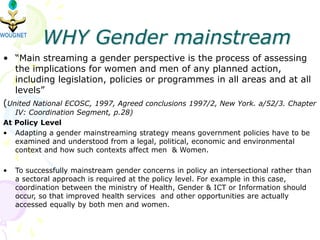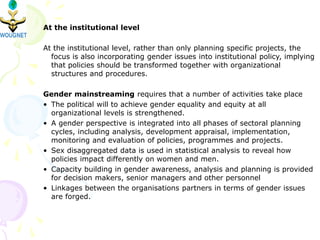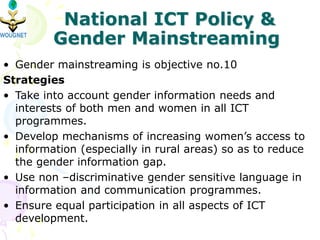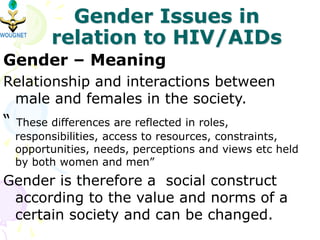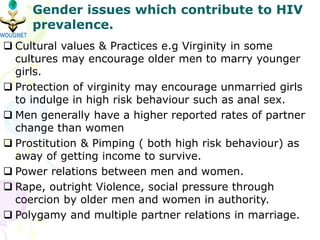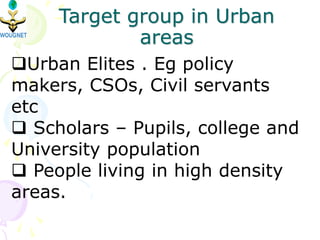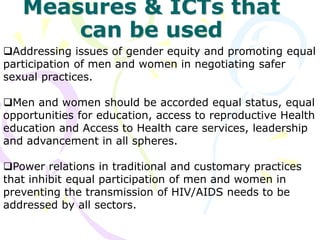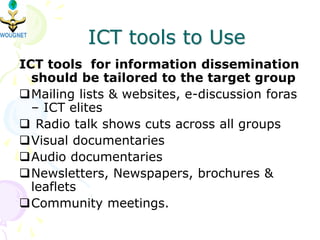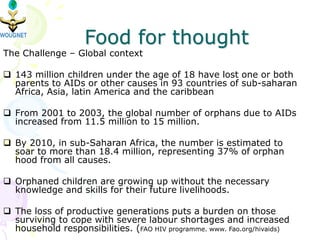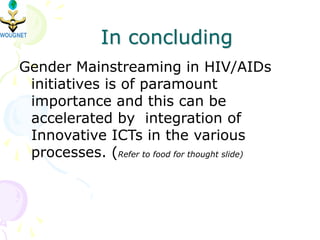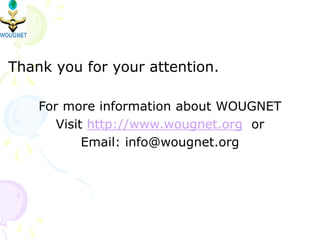Integrating ICTs in Gender-mainstreaming, Munyonyo _ Uganda
- 1. Integrating ICTs - Gender Mainstreaming-HIV/AIDs in an Urban Setting Janet C Achora. info@wougnet.org Women of Uganda Network HIV-AIDS and Gender Mainstreaming Workshop for Parliamentary HIV-AIDs Committee Speke Resort Munyonyo 14 -16th June 2007
- 2. Outline of the Presentation ïą Introduction - Why ICTs ïą National Policy and Gender mainstreaming ïą Gender issues in relation to HIV/AIDS ïą Gender issues which contribute to HIV transmission ïą Target groups in Urban areas. ïą Measures and ICTs that can be used ïą ICT tools to use ïą Food for thought ïą Conclusion
- 3. Introduction- Why ICTs Ugandaâs ICT Policy defines ICTs as â Technologies that provide an enabling environment for physical infrastructural and services development for generation, transmission, processing, storing and "disseminating information in all forms including voice, text, data, graphics and Videoâ
- 4. WHY Gender mainstream âĒ âMain streaming a gender perspective is the process of assessing the implications for women and men of any planned action, including legislation, policies or programmes in all areas and at all levelsâ (United National ECOSC, 1997, Agreed conclusions 1997/2, New York. a/52/3. Chapter IV: Coordination Segment, p.28) At Policy Level âĒ Adapting a gender mainstreaming strategy means government policies have to be examined and understood from a legal, political, economic and environmental context and how such contexts affect men & Women. âĒ To successfully mainstream gender concerns in policy an intersectional rather than a sectoral approach is required at the policy level. For example in this case, coordination between the ministry of Health, Gender & ICT or Information should occur, so that improved health services and other opportunities are actually accessed equally by both men and women.
- 5. At the institutional level At the institutional level, rather than only planning specific projects, the focus is also incorporating gender issues into institutional policy, implying that policies should be transformed together with organizational structures and procedures. Gender mainstreaming requires that a number of activities take place âĒ The political will to achieve gender equality and equity at all organizational levels is strengthened. âĒ A gender perspective is integrated into all phases of sectoral planning cycles, including analysis, development appraisal, implementation, monitoring and evaluation of policies, programmes and projects. âĒ Sex disaggregated data is used in statistical analysis to reveal how policies impact differently on women and men. âĒ Capacity building in gender awareness, analysis and planning is provided for decision makers, senior managers and other personnel âĒ Linkages between the organisations partners in terms of gender issues are forged.
- 6. âĒ Gender mainstreaming is objective no.10 Strategies âĒ Take into account gender information needs and interests of both men and women in all ICT programmes. âĒ Develop mechanisms of increasing womenâs access to information (especially in rural areas) so as to reduce the gender information gap. âĒ Use non âdiscriminative gender sensitive language in information and communication programmes. âĒ Ensure equal participation in all aspects of ICT development. National ICT Policy & Gender Mainstreaming
- 7. Gender Issues in relation to HIV/AIDs Gender â Meaning Relationship and interactions between male and females in the society. â These differences are reflected in roles, responsibilities, access to resources, constraints, opportunities, needs, perceptions and views etc held by both women and menâ Gender is therefore a social construct according to the value and norms of a certain society and can be changed.
- 8. ïą Cultural values & Practices e.g Virginity in some cultures may encourage older men to marry younger girls. ïą Protection of virginity may encourage unmarried girls to indulge in high risk behaviour such as anal sex. ïą Men generally have a higher reported rates of partner change than women ïą Prostitution & Pimping ( both high risk behaviour) as away of getting income to survive. ïą Power relations between men and women. ïą Rape, outright Violence, social pressure through coercion by older men and women in authority. ïą Polygamy and multiple partner relations in marriage. Gender issues which contribute to HIV prevalence.
- 9. Target group in Urban areas ïąUrban Elites . Eg policy makers, CSOs, Civil servants etc ïą Scholars â Pupils, college and University population ïą People living in high density areas.
- 10. Measures & ICTs that can be used ïąAddressing issues of gender equity and promoting equal participation of men and women in negotiating safer sexual practices. ïąMen and women should be accorded equal status, equal opportunities for education, access to reproductive Health education and Access to Health care services, leadership and advancement in all spheres. ïąPower relations in traditional and customary practices that inhibit equal participation of men and women in preventing the transmission of HIV/AIDS needs to be addressed by all sectors.
- 11. Measures contâĶ ïąCustomary practices and cultural institutions that provide opportunities for public awareness to be utilised for empowerment and dissemination of information on Reproductive health and HIV/AID ïąCommunity programmes to address issues of multiple sex partners and the issues of Gender and reproductive rights in relation to HIV/AIDs transmission ïąIntegrated quality and user friendly reproductive health services to be made accessible to men, women and youth.
- 12. ICT tools to Use ICT tools for information dissemination should be tailored to the target group ïąMailing lists & websites, e-discussion foras â ICT elites ïą Radio talk shows cuts across all groups ïąVisual documentaries ïąAudio documentaries ïąNewsletters, Newspapers, brochures & leaflets ïąCommunity meetings.
- 13. Food for thought The Challenge â Global context ïą 143 million children under the age of 18 have lost one or both parents to AIDs or other causes in 93 countries of sub-saharan Africa, Asia, latin America and the caribbean ïą From 2001 to 2003, the global number of orphans due to AIDs increased from 11.5 million to 15 million. ïą By 2010, in sub-Saharan Africa, the number is estimated to soar to more than 18.4 million, representing 37% of orphan hood from all causes. ïą Orphaned children are growing up without the necessary knowledge and skills for their future livelihoods. ïą The loss of productive generations puts a burden on those surviving to cope with severe labour shortages and increased household responsibilities. (FAO HIV programme. www. Fao.org/hivaids)
- 14. In concluding Gender Mainstreaming in HIV/AIDs initiatives is of paramount importance and this can be accelerated by integration of Innovative ICTs in the various processes. (Refer to food for thought slide)
- 15. Thank you for your attention. For more information about WOUGNET Visit http://www.wougnet.org or Email: info@wougnet.org

